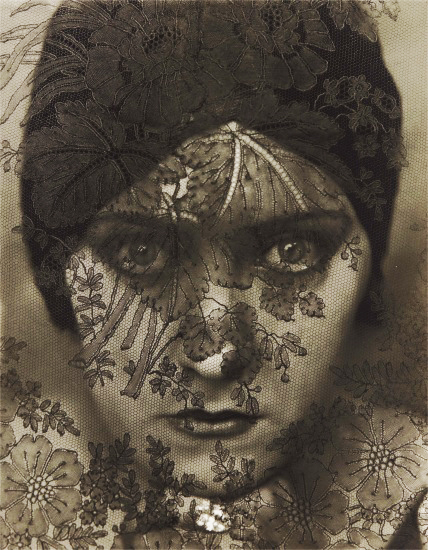Gloria Swanson, New York, 1924

Gloria Swanson was one of the greatest of the silent movie stars, able to captivate audiences with her eyes. This skill was of course paramount when your eyes alone, rather than dialogue, had to convey the emotion required for each scene. She had the spellbinding ability to transfix audiences with her screen presence, her wide-eyed expression key to whatever emotional role she was playing.
Edward Steichen took this remarkable portrait of Swanson in 1924, just before the arrival of sound was about to transform cinema. Steichen later explained that, ‘At the end of the session, I took a piece of black lace veil and hung it in front of her face. She recognised the idea at once. Her look was that of a leopardess lurking behind shrubbery, watching her prey.’
This audacious move by Steichen, who was commissioned to produce a routine, pleasingly-appealing portrait of the star, created one of his most enduring and celebrated images.
Born in 1879 in Luxembourg, his family moved to the United States, where Steichen grew up in a household burdened by the struggle of financial hardship. At age 15, he managed to secure an apprenticeship in a lithographic firm, but found himself becoming intrigued by the invention of the portable photo camera, and saved up to acquire a second-hand little Kodak.
He was soon desperate to travel to France, where he knew trends in photography were swiftly advancing. Moving to Paris in 1900, he was fortunate enough to meet the great photographic pioneer Alfred Stieglitz, who was immediately struck by the prodigious talent of young Steichen.
Stieglitz bought some of his prints, and began a collaboration that would continue for many years, hiring Steichen to become the principal photographer for his new magazine launching in New York, ‘Camera Work’. They also established a small avant-garde art gallery together, which famously presented the first US exhibitions of Cezanne, Picasso, Matisse and Rodin.
Steichen’s reputation grew to the point that he was asked to photograph the latest gowns for Jardin des Modes magazine, creating one of the early breakthroughs in fashion photography. He transformed it from static shots of models as mannequins, into an expressive new art form.
As Steichen explained about his approach ‘Most photographers seem to operate with a pane of glass between themselves and their subjects. They just can’t get inside and know the subject. A photograph is worth a thousand words, provided it is accompanied by only ten words’.
World War One found him as a military photographer in various combat zones, but by 1923 he was able to run his own studio, and during the next decade Steichen became one of the highest paid and most renowned photographers in the world.
The Hollywood elite, and it appears anyone else of note, was desperate to sit for Steichen. By 1932 Marlene Dietrich, Greta Garbo and other screen goddesses all wanted the magic Steichen touch that he had brought to Gloria Swanson. However, he finally decided to close his studio in 1938, and wanted to concentrate on gardening.
But Steichen was such an authoritative figure, and considered such an inspirational force amongst his peers that he was appointed Director of Photography at New York’s Museum of Modern Art, a position he held until 1962. He helped produce many seminal exhibitions, most memorably the legendary overview ‘The Family of Man’, consisting of over 500 works from around the world. It was seen by a record-breaking 9 million visitors, and took photography to unprecedented new status within the art world.
However, of course, his most enduring legacy is the extraordinary brilliance of his work. As early as 1900 after his move to Paris, he was producing masterpieces. His pictures of Rodin remain amongst the most incisive examples of early photographic portraiture.
He had become close friends with the sculptor when they were neighbours on Montparnasse, and his ‘Rodin, le Monument à Victor Hugo et Le
Penseur’, 1900, is as beguiling today as it was the day it was completed. Showing Rodin sitting in profile on the left, and his sculpture ‘The Thinker’ to the right, towering between them is the presence of a vast plaster cast of the writer Victor Hugo.
It would be hard to imagine a neater way to express the philosophical links between art and literature, with Steichen placing himself central to the debate, as its enabler. When this picture was displayed, photography began to be regarded as a legitimate tool in the development of modernist art.
Even late in life Steichen continued to experiment with innovative new techniques. At his 90th birthday celebration, he declared, ‘When I first became interested in photography, I thought it was the whole cheese. My idea was to have it recognized as one of the fine arts.
‘Today I don’t give a hoot about that. The mission of photography is to explain man to man, and each man to himself. And that is no mean function. Man is the most complicated thing on earth, and also as naive as a tender plant.’
Steichen’s place in the pantheon of the very finest photographers lay in great part on his inherent ability to sense the aura of his subjects, whether they were glamorous film stars, or buildings as singular as the early little Flatiron skyscraper in New York. Both were treated equally, with a penetrating fresh perspective that made much of his work so dramatically compelling.
